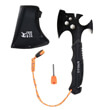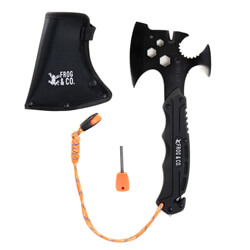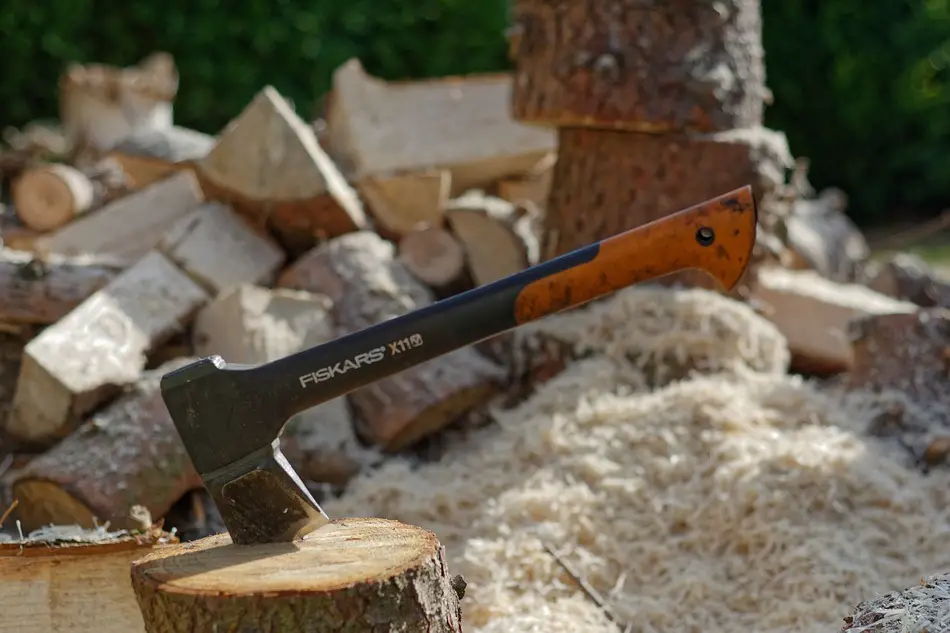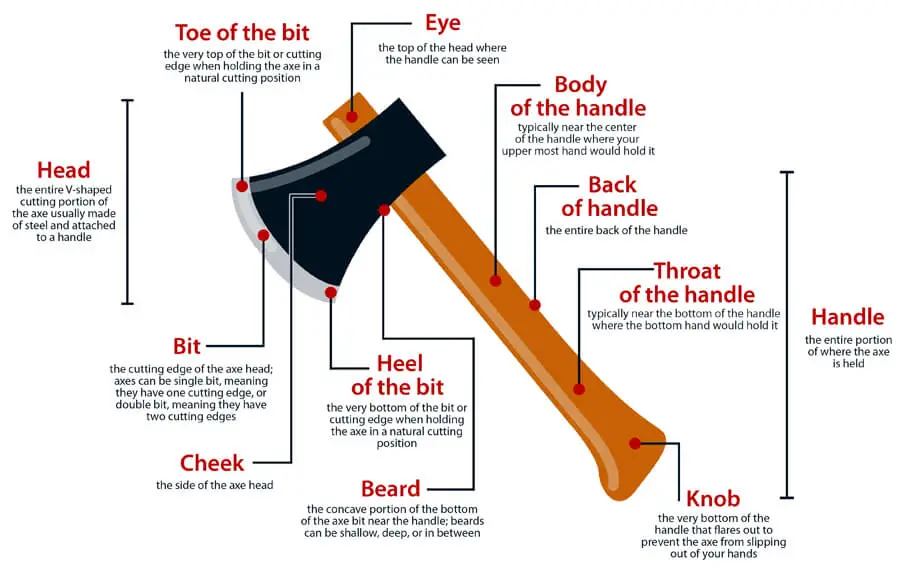Survival axe is an incredibly useful and versatile tool, both in survival situations as well as in regular camping and outdoor activities. Survival axes and hatches can be utilized in a wide variety of tasks, such as chopping wood, building a shelter, hunting, self-defense, and even shaving!
The main question you might ask, is how to choose the very best survival axe among all those available today? Fear not, for I have written this detailed guide that will define exactly what you need to look for in a survival axe, what parts it’s made of and how you can take care of it. Moreover, I have listed 5 top survival axes for you to choose from and added a verdict: which one in my opinion is the best of the best.
Let’s begin, shall we?
Top 5 Survival Axes
| Preview | Title | Features | More Details |
|---|---|---|---|
 |
Off Grid Tools Trucker’s Friend Demolition & Multi-tool | • All-purpose tool • 31 different features • Strong steel and fiberglass |
 |
 |
CRKT Woods Forged Carbon Steel Wood Hickory Handle Axe | • Maximum strength and durability • Curved blade allows deeper bites • Lifetime warranty |
 |
 |
SOG Tactical Tomahawk | • Tactical throwing axe • Ultra-sharp • Ideal for wood chopping |
 |
 |
Fiskars Chopping Axe S X10 | • Coated and hardened steel blade • Ideal for camping and survival • Comfortable to hold |
 |
 |
Zombinator™ Survival Hatchet | • Multi-tool axe • Chops through almost anything • Has sockets, pry bar, paratinder cord, and more |
 |
What’s The Difference Between a Survival Axe and a Hatchet?
Survivals axes, hatchets and tomahawks are three quite similar tools, therefore people tend to confuse between them. An axe is much bigger and stronger than a hatchet and a tomahawk. A hatchet is much more convenient to carry inside a backpack, as it’s smaller and lighter, while an axe is more likely to be stationary and stored in the house, garage or vehicle.
The length of a hatchet and a tomahawk is less than 12”, while the length of a survival axe is longer than 22”.
Basically, a hatchet is usually defined as a small axe or a tool that is inspired by an axe. The hatchet will mostly be used for trimming and splitting, while the axe can be used for cutting, breaking, digging and other purposes I will mention soon.
Another main difference between the two is that you only need to use one hand to operate the hatchet, while with the axe, you’ll be using both hands in order to maximize the power of the strike.
We have more details about hatchets on this blog, please check out our buyer’s guide for survival hatchet.
Why Do You Need a Survival Axe?
A survival axe is one of the most important and useful tools to have outdoors, and especially during survival, life-and-death situations. So, if you’re asking yourself why would you need a survival axe for, here are the main reasons to consider before adding it as part of your crucial survival gear:
- Building a shelter – Using a good and sturdy survival axe allows you to cut branches and chop wood and foliage in order to build a shelter.
- Building a fire – By using the axe, you can make firewood to build and start a fire. Chop firewood, and then shave it to be used as tinder. Then, ignite it and just like that, you have yourself a fire to stay warm, cook, boil and even scare away animals and insects.
- Hunting – You can use the axe to hunt animals for food. A strong survival axe can cut bones and even break shells.
- Digging and movement – In case you’re moving on tough ground, like ice or snow, use the axe to break the ground to pave your way and move more freely.
- Self-defense – A survival axe can be used as a weapon and a self-defense tool, especially against predators and other big, threatening animals in the wild.
- Opening bottles – Open bottles by wedging the blade or butt of the axe under the bottle’s cap and then add some leverage to open the bottle.
- Shaving – Using the axe’s blade, you can even shave outdoors. Shaving properly and safely with the axe takes time and practice, so be careful.
Parts of a Survival Axe
Every axe is comprised of a few main parts that are important to get familiar with:
- Blade – This is the most important part of the axe. When choosing a survival axe, look for an axe that features a blade made of carbon steel. This will ensure your blade lasts for a long time. In case the blade of the axe gets cracked or chipped, then consider getting a new axe.
- Handle – The handle is the long and straight piece you will be holding while operating the axe. The handle can be made of hickory wood, metal, plastic or fiberglass. The material of which the handle is made of will affect the axe’s weight and durability.
- Butt – The flat butt of the axe is located at the head’s back.
- Head – Commonly forged with low carbon steel, as opposed to the high carbon steel used for the blade. This is how the Vikings used to make their axe heads. This composition ensures that the tool is durable and long-lasting.
- Lug – Located at the bottom of the axe’s head on both sides of the handle. Its purpose is to firmly attach the head to the handle.
- Eye – This is the hole in the head of the axe, where the handle attaches.
How to Choose a Survival Axe?
I will go over the factors to consider when choosing a survival axe. I’ve already mentioned earlier the differences between an axe and a hatchet, so the factors here focus on choosing a survival axe.
The Axe’s Blade and Head
When talking about an axe, the mind immediately thinks about the blade, as it’s probably the most important part of the tool, as I’ve mentioned above. Looking at the blade and the head, there are a few things to consider: the shape and design of the edge, the length of the blade, and the thickness.
- Design – The design of most survival axes features a curved axe-head, but there are axes that come with flatter edges too. As for the shape of the edge: if you need to cut through wood, then consider getting a flatter edge, as the entire blade will hit the wood with each strike, as opposed to a curved edge where you won’t make full contact with every strike. On the other hand, a flat edge may get stuck on a flat surface. So, always consider your needs and what it is you will be cutting to know whether to get a flat or curved edge axe.
- Length – The length of the blade is approximately 3.5”.
- Thickness – As for thickness, axes with thicker cheeks provide more weight as well as more power to the axe’s head when chopping. A thick cheek means more inertia and leverage when you swing the axe head. If you use an axe with thin cheeks, then the blade will get stuck halfway through the log during copping. An axe with a thick cheek will cut the log clean. The lateral force of a thick cheek is significantly higher. Again, choose the axe according to your needs and uses. If you’ll be using it mostly for cutting, chopping firewood and other camp activities, then a thick cheek is preferred. On the other hand, if you’ll be using the axe mainly for carving, intricate work or hunting, then prefer one with thin cheeks.
Handle Materials
Not all axes are made of the same materials. There are four materials that an axe handle can be made of:
- Fiberglass – A handle that is made of fiberglass material will be strong yet lightweight, making it a great choice. Chances of the handle to break are slim, and you don’t have to oil it (as opposed to wood) or do anything special to maintain it.
- Wood – You will find a handle made of wood in a lot of axes from top-quality brands. The reason is because a wooden handle features better flexion as well as shock-absorption qualities. A wooden handle lasts for many years, as is it tough and rugged. Most wooden handles are made of US hickory. Just remember to oil it from time to time for better maintenance and longer shelf life, since the oil prevents the wood from getting dry. The oil also lowers the probability of the handle splitting in your hands during a task.
- Full tang – With this design, both the handle and the axe-head are made of metal or alloy, making the axe pretty heavy, as compared to other materials.
- Polymer – Handles that are made of polymer are lightweight just like the fiberglass handles, yet they don’t offer the same shock-absorption and durability. Polymer is least recommended for survival axes, and you will mostly find it in cheaper models, where the manufacturer wishes to save money on production.
Handle Length
The length of the handle is another factor to consider when getting an axe. If you need to chop wood and split logs, then get an axe with a long handle, as this gives you more leverage, thus making the task of cutting and splitting a lot easier and more convenient. An axe with a long handle also allows you to move and swing the head of the axe faster, for more power and bigger impact. With that said, bear in mind that longer handles also mean a heavier axe.
There are also axes with short handles under 14”, and these axes can fit in your backpack. As always, choose the length of the handle according to your needs. Need more power and momentum when swinging and hitting? Choose a longer handle.
Handle Grip
When working and performing various tasks with the axe, it is important that the axe will feel comfortable in your hands, but at the same time be safe and not slip or fall from your hands.
A handle that is made of polymer comes with textured grip. This allows you to control the axe better, so it won’t slip from your hands, especially if it’s raining, foggy or humid outside. On the other hand, a handle that is made of wood doesn’t feature a textured grip, meaning that in wet and damp weather conditions, the axe may slip away from your hands.
Both materials are good, but for wet weather, it’s best to get a polymer handle. Either way, choose an axe that feels comfortable, and is easy to hold and use.
Weight
The weight of your axe can play a huge part, not only when you’re carrying it with you, but especially during survival situations you may face. When it comes to emergencies and survival, it is best to have a lightweight axe. It is easier to handle and operate, and you waste less energy in the process. So, if the purpose of your axe is for survival situations, go for a lightweight axe.
As mentioned earlier, lightweight axes will be those with shorter handles, made of fiberglass or polymer materials and axes that feature thinner axe-head. This does not mean that this axe is not good or less efficient than the other axes, it’s just the best axe for survival situation, due to it being lightweight.
Even if you’re not in danger and you simply want to use the axe in the campsite, you can always go for a lightweight axe. Just remember to have the right axe for the right uses and purposes. Get a lightweight axe if you plan on travelling with it on you and having it serve you in survival situations. On the other hand, if the axe will be stationary, put in the garage, car, or camp, then the weight is a less important factor here.
Multi-Tool Axe
You can get a “regular” axe or an axe that features other tools and items, making it a multi-tool axe. As always, it all comes down to your personal use of the axe. The primary use of an axe is to cut and split, especially trees and logs. But if you’re planning to do more with the axe, then you should consider getting a multi-tool axe.
Some axes are designed with a hammer on the butt edge of the eye. This means that you can use the axe as if it was a hammer. Other designs feature cheeks that are thinner and can be turned into a shovel or a knife. Other items and tools that may be included in or with the axe are a glass hammer, spike, saw, flint, and more. So, according to your needs and uses, decide whether you are good to go with a plain survival axe, or you prefer more items to be included, making your axe a multi-tool axe.
How to Care for an Axe?
Just like any other tool, you should and need to take care of your survival axe, so that it lasts and functions for a long period of time. Here are the necessary steps to take in order to maintain your survival axe:
- Sharpening the axe – Sharpening the blade of the axe is essential for its proper use. If the blade is dull, your axe won’t be effective at chopping or cutting trees. One way to sharpen the axe’s blade is by using an axe whetstone.
- Dealing with rust – Rust will most definitely hurt and damage the blade of the axe. It harms the metallic structure and harshly reduces the blade’s sharpness. However, avoiding rust is easy to accomplish. Simply store the axe in a dry place and keep it away from moisture, and that’s it. If you happen to work with it under wet conditions, remember to dry the blade at the end of the work. Also, many axes feature nylon or leather sheaths, so covering the axe with the sheath will keep it safe from moisture and damage. If the blade does catch some rust on it, try using Vapor Rust, WD-40, vinegar and fine steel wool to fight the rust and remove it from the blade.
- Replacing the head or handle – In some designs, you can replace the axe’s head and handle. If you’ll be using the axe on a regular basis, then there is a chance that at some point you’ll need to replace its head or handle. If the manufacturer offers warranty and it’s still valid, you can activate it and save money. However, if you need to change the head of the axe, consider getting a new axe. As for the handle, some may splinter, break or rot (like in the case of wooden and some other handles). In that case, use a hammer to take the damaged handle out from the axe head’s eye, and then insert a new handle. You can get a new handle at most hardware stores or on Amazon by clicking this link.
- Cleaning and maintaining – When you’re done using the axe, always clean it, store it in a dry place and cover it with a sheath. Clean the head of the axe by using steel wool and acetone. Then, clean the handle to remove dirt and sap. If the handle is not dirty, then it’s possible to use a bit of extra fine steel wool as well as turpentine. On the other hand, if the handle got significantly dirty or was affected by the weather, you’ll need to make it smooth again by using a hand sander. Now, oil the handle with boiled linseed oil (BLO), and then oil the axe head. The oil will protect the metal and help the axe cut deeper and faster. You can oil the head using light oil (such as Rem Oil), or use BLO to oil both the head and handle.
Here is an excellent video that teaches how to take care of your survival axe:
Safety Tips and Proper Use
An axe is a tool that should be operated in a safe manner, as it can be dangerous if things are not done properly. That is why I would like to point out a few important safety tips and principles to avoid unfortunate accidents.
- Always hold the axe with both hands when swinging to chop wood.
- Do not chop or use the axe around people.
- When working with the axe and chopping wood, always do it in a designated area.
- Prefer working with the axe in open spaces and beware of hazards nearby, like stones and pebbles.
- Decide on the path of the swing and make sure you are positioned away from it.
- On the same note, should the axe glance off the wood, it should not go in the direction of your body. So swing according.
- When working with the axe in cold weather, always warm the axe head beforehand.
- When done using the axe, remember to sharpen it.
- When not using the axe, always cover it in a sheath to protect it and prevents injuries and accidents.
- Always carry the axe with its sheath on, to prevent injuries and accidents from the blade.
- Always carry the axe facing down (edge to the ground).
Best Survival Axes
Let’s have a look at some of the best survival axes available on the market today. I will feature different axes and even a brilliant hatchet, so you’ll have the chance to pick the right axe for your needs and uses. From chopping wood, to tactical axes all the way to a Zombinator survival hatches, here are the best survival axes and hatchets that I recommend. For your convenience, I linked the recommended tools to their Amazon and SurvivalFrog pages.
Off Grid Tools Trucker’s Friend Demolition & Multi-tool
This is not just a survival axe, but a multi-tool with 31 different features. It’s basically an all-purpose tool that answers the needs of truckers, campers and survivalists.
Made in the USA, this axe head is made of 1055 carbon steel and the handle is made of strong fiberglass. It is lightweight and also features a nice rubber grip that also absorbs shock when in use.
Because this is a multi-tool axe, it also comes with a hatchet blade, hammerhead, pry bar, nail claw, hardened steel glass breaker, seat belt cutter, bottle opener, gas valve wrench, fail-safe whistle, thermometer and compass, flat screwdriver, carbide blade sharpener, firestarter, and more.
The saw blades can be replaced if needed and with the axe, you also get adjusted sheaths that can withstand even harsh weather, to protect the axe and avoid injuries that can be caused by the sharp blade.
Click here to read more reviews and compare prices.
CRKT Woods Forged Carbon Steel Wood Hickory Handle Axe
Ryan Johnson is the designer of this fine axe. For years, he has been building custom and high-quality tomahawks, and this axe is one of them.
The blade is made of 1055 carbon steel for maximum strength and durability, and the handle is made of Tennessee hickory wood that can withstand the hardest of uses.
The design of the curved blade allows deeper bites even into hard wood with a handle that is smooth and built especially for chopping. Sheaths are also available, yet sold separately.
Another thing that is worth mentioning is the limited lifetime warranty the covers any defects of the axe.
Click here to read more reviews and compare prices.
SOG Tactical Tomahawk
This is a tactical axe that you can throw, as it swings really fast. According to the SOG company that was founded in 1986 and is based in Seattle, WA, this tactical axe can do anything a regular axe can do, and then some.
The blade is ultra-sharp 2.5” that is made of 420 stainless steel, yet the axe remains and feels lightweight, as it weighs only 1.5 pounds. This survival axe also features a flat edge for hammering and a spike for piercing, so you can use it in emergency situations. As for chopping wood, it is suitable for small wood chopping, being that it is more of a tactical survival axe and tool.
The handle is made of high-impact glass-reinforced nylon. It is also extended to provide you comfort and more leverage when using the axe. The axe is great for chopping (preferably small wood), breaching, hammering and piercing.
Along with the axe, you also receive a belt loop nylon sheath to protect the axe and avoid injuries.
SOG company will gladly consider any repair or replacement for your items and tools, if requested.
Click here to read more reviews and compare prices.
Fiskars Chopping Axe S X10
Made in Finland, this is another great axe, which is also known as a universal hatchet. The blade is made of hardened steel and features high quality coating. This allows you to cut and split logs up to 4 inches / 10 cm in diameter. The axe is ideal for camping, hiking, survival, outdoor activities, and even for construction and woodwork.
The handle is made of fiberglass reinforced plastic. It is extremely durable and resistant to impact as well as to various weather conditions. The axe is very comfortable to hold and also firm, due to the innovative handle that features a textured non-slip coating and hook end for a perfect grip. Thanks to these features, you won’t have to worry that the axe will fall or slip from your hands.
The blade can be easily sharpened using a blade sharpener. Due to its small dimensions, being only 44 cm long and weighing at 980 g, you can easily store it inside your backpack and take to any outdoor activity you desire. Storage and carrying cases are also included for better maintenance and safety.
Click here to read more reviews and compare prices.
Zombinator™ Survival Hatchet
 This tool is a multi-tool axe or hatchet, but however you wish to call it, it’s a very cool item in my opinion. The blade is full tang, made of 420 stainless steel. It’s strong and very sharp, meaning you can chop through almost anything, even if there are zombies in your way. Because it is also a multi-tool, it has 10 other available functions.
This tool is a multi-tool axe or hatchet, but however you wish to call it, it’s a very cool item in my opinion. The blade is full tang, made of 420 stainless steel. It’s strong and very sharp, meaning you can chop through almost anything, even if there are zombies in your way. Because it is also a multi-tool, it has 10 other available functions.
You can use it as a hammer or as a pry bar. The hatchet can be used to pull nails out. It also features 4 hex sockets that are carved into the axe head (3/8, 7/16, 1/2, 9/16), flammable paratinder cord in case you need to start fire, seat belt cutter, glass breaker, and even a 120-decibel whistle to call for help in case of an emergency.
- Dimensions: 11.25″ L x 75″ W x .25″ H Thickness x 1″ Handle Thickness.
- Weight: 1.7 lbs.
Click here to read more reviews and compare prices.
Final Verdict: Which is the Best Survival Axe?
Choosing the best survival axe from the list above is like choosing a favorite child. All of these axes and hatchets are excellent, I and other experts and survivalists have used them frequently.
If I have to choose one, however, I would go for Off Grid Tools Trucker’s Friend Demolition & Multi-tool. For me, it wins the contest thanks to the sheer amount of available tools it includes. When facing extreme and unfamiliar situations outdoors, having a variety of survival tools is a huge advantage. And this survival axe comes with a whooping number of 31 multi-tool features! I would definitely take it to any camping adventure and fully rely on it when in a survival situation.
Keep in mind that every axe is suitable for different needs. If you need an axe to mostly chop wood, then I would suggest picking a different one from the list above.
Frequently Asked Questions
In this section, I would like to answer some questions that arise on the topic of survival axes, so let’s cover them up.
Axe vs Hatchet for Camping?
Use an axe if you need to cut and break big pieces of wood. If you need to cut or chop logs or wood as thick as your arm or smaller, then use a hatchet.
Naturally, there are other important tools that you can take with you on camping – read more in my article on what you should bring to a camping or hiking trip.
Is It Legal to Carry an Axe?
Generally speaking, it is legal to carry an axe with you as long as you use it as a tool. The moment you start using it as a threat, then it can legally become a weapon. So thread responsibly and carefully while using an axe.
How Strong Is 1055 Carbon Steel?
In this article, I have mentioned axes with blades made of 1055 carbon steel. It’s actually quite impressively strong, having a quenched hardness in the range of 60 to 64. Thanks to its tensile strength and resistance to abrasion, this type of steel creates highly durable and strong tools. It also has an ideal edge retention, perfect for axes.
Final Words
There you have it, a complete guide on selecting the best survival axe for you. As you can see, choosing this versatile tool requires extensive knowledge, which hopefully I was able to provide for you.
I have mentioned models that include a multi-tool. If you are interested to find out what the best non-axe multi-tool is and how to select one, I invite you to read my article on best multi-tools for survival and outdoors.
A shovel is another universal tool that can greatly help you with your survival and camping needs. Some shovels also function as a multi-tool, which you can find out about in my post about best survival shovels today.
Feel free to browse my blog for more useful information on survival gear and survival skills.
Stay safe out there!






